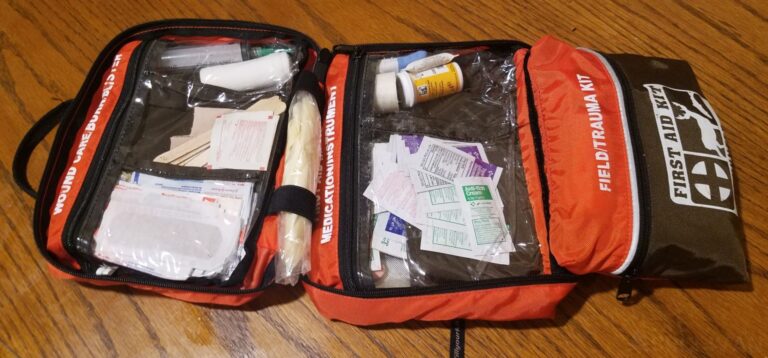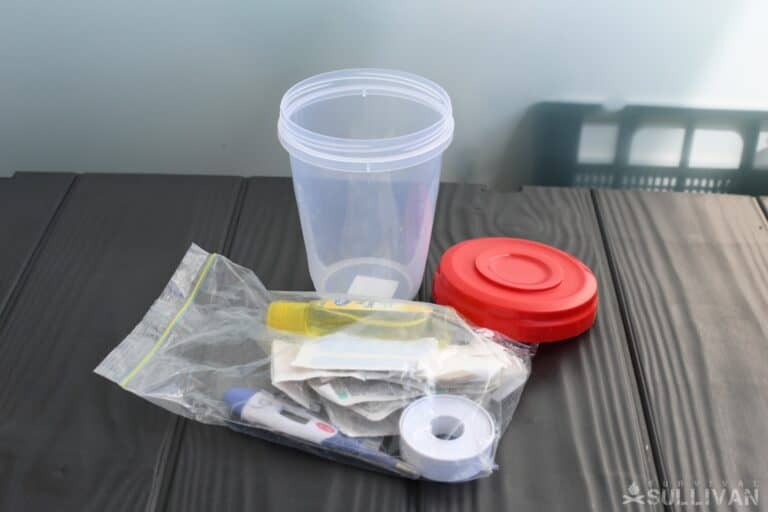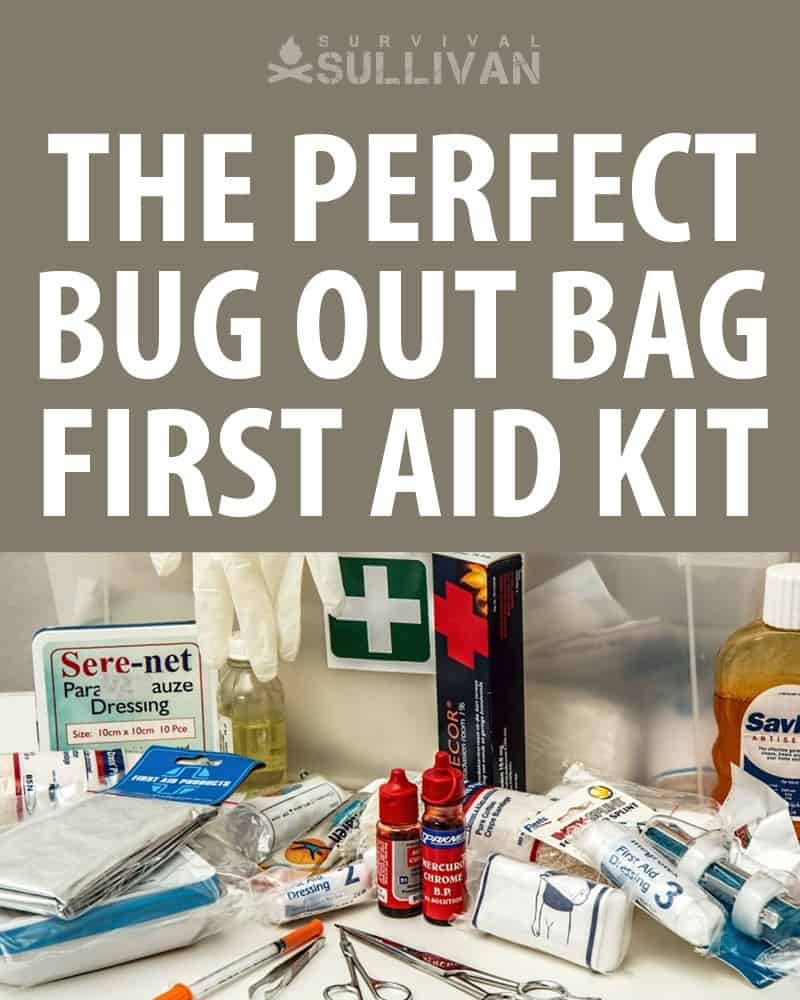When things go wrong, and especially when SHTF, your level of medical preparedness can be critical to your survival or the survival of your family members.

Many people who begin to learn about prepping, bugging out, and being prepared get sucked into the gear buying vortex created by the survival/prepping industry. It is an industry.
And it’s important to keep in mind that while buying what seems like the perfect bug out bag first aid kit online makes it easy and convenient, it’s not your only choice. But when SHTF and you need to bug out, having a first aid kit for your bug out bag is going to be critical.
Buying the Perfect Bug Out Bag First Aid Kit
If you are going to purchase a comprehensive bug out bag first aid kit online or even from a store, make sure you do your research.
Get a kit manufactured by a reputable company, read reviews from verified purchasers first, and carefully review the included contents to ensure you are getting quality items. There are several companies out there that have been recommended by experienced preppers.
Once you purchase your kit, inventory the contents carefully to determine if there are additional items that should be added to make it comprehensive for your needs.
It’s also important to get the first aid training needed to assess injuries and illnesses correctly and to properly use all of the items in your kit. Yes, something is better than nothing in a medical emergency but when your life depends on what you pull out of your kit, make sure it’s going to be reliable and you know how to use it.
The Basic First Aid Skills Everyone Should Learn include:
- Cleaning and Bandaging Wounds
- CPR for Infants/Toddlers and Adults
- Identifying and Treating Shock in Children and Adults
- Proper Heimlich Maneuver for Adults and Children
- How to Make and Apply a Sling
Other Skills You May Want to Learn for a SHTF Medical Situation Include:
- Treating Dental Emergencies (you will need a separate kit for these)
- Identifying and Treating Infections
- How and When to Suture Safely
- Identifying and Using Medicinal Plants
- Which Painkillers Work
Why and How to Make a DIY First Aid Kit for Your BOB
Many of the first aid kits available online or in stores come in fancy, labeled containers with divided contents that make it quick and easy to find and access your supplies.
Don’t be fooled by the packaging. You don’t HAVE to buy a first aid kit. In fact, many of the first aid kits available for sale are not high quality at all and may actually fail you when you need them most.
Experienced preppers know that it’s perfectly acceptable to make a DIY first aid kit for your BOB and in many cases, it may even be more reliable.
Part of what happens when you put together your own first aid kit is that you have a much more thorough understanding of what is in your kit.
This works in your favor in an emergency because instead of a sealed first aid kit you bought and never looked at, you have a customized first aid kit that you put together yourself.
When you put together your own first aid kit, you also know the quality of the items you’ve included. You know that when you need to rely on them to treat an injury or even save a life, your supplies will hold up.
What to Include in Your DIY First Aid Kit for your BOB
The overall purpose of a first aid kit is to provide the supplies you may need to intervene in a serious medical situation such as a car accident, drowning, or accidental fall.
But a first aid kit is also designed to help with life’s minor illnesses and injuries such as cuts, bruises, scrapes, fever, infection, etc.
Most basic first aid kits are meant to provide treatment until professional medical help, such as EMS, nurses, or doctors, can take over medical care. But when SHTF or a natural disaster occurs, there may not be professional medical help available when you need it or even at all.
This is why it’s critical to ensure that your DIY First Aid Kit for your BOB includes items to provide more detailed medical care whenever possible.
You Need Items for Lesser Injuries
Not every use of your first-aid kit is going to involve screaming and agony. Many injuries and “boo-boo’s” crop up that might only be annoyances, but they should still be treated.
You’ll want supplies for cleaning and bandaging cuts, scrapes, and splinters.
You’ll also want to include supplies for treating blisters, small burns, bites and stings. Moleskin, aloe vera packets, calamine lotion and such will be just the ticket.
These minor injuries could portend worse things to come if ignored and, as always, better safe than sorry. Infection has historically been a massive killer, and though it is a triviality today thanks to antibiotics, you shouldn’t take it for granted.
In deep country if you don’t have antibiotics you sure as hell won’t have a doctor nearby to issue them to you. A small cut or nasty blister that gets infected could literally cost you an arm or a leg. Maybe even your life.
Particularly during legitimate survival scenarios in the wake of a major event, the likelihood that a small cut or puncture could become infected rise exponentially.
Dirt, debris, blood, body waste and other hazards will readily infect any breach in the skin.
For that reason, it’s important to have supplies for the lesser injuries, and to use them when they arise.
Don’t wait until you have a raging infection to take care of that cut on your finger – clean and bind it up as soon as it happens. You’ll save yourself a lot of pain down the road and prevent disaster.
You Need Items for More Serious Injuries
Of course, you’ll also want supplies for more serious injuries. Any disaster worth being called such is going to itself be a source of calamitous trauma, and the second and third order effects can likewise mangle people.
A tornado could blow your house down, crushing a leg, only for you to be impaled by collapsing debris and then shocked by a down powerline.
A riot could see you shot by rampaging bad guys, tear gassed and then run over by some other person trying to avoid it in a panic. Some events are literal buffets of carnage!
Your big sources of trauma are lacerating, penetrating and blunt force injuries. These could be caused by knives or flying, twisted metal, gunshots or impalement on rubble, or being crushed under wreckage or a stampede of people.
None of them are pleasant, and you must be proficient at dealing with all of them using the supplies you have on hand.
Exsanguination, bleeding out, is a perennial killer and particularly when it is from an extremity. If someone is bleeding heavily, you’ll need to pack clotting agents, bandages, and tape. Blunt force injuries incurred from fighting or car wrecks will cause internal damage and broken bones.
If there is a fracture, you’ll need to immobilize the area with splints. Pain and shock are problems all unto themselves.
If someone is suffering from a heart attack or an allergic reaction, you’ll need to administer CPR or EpiPens accordingly.
The key to a good trauma complement for your first-aid kit is packing supplies that can address a wide variety of potential injuries. By being prepared for anything, you can help ensure that everyone stays safe – even when the going gets tough.
DIY First Aid Kit Containers
One of the most important yet often overlooked component of your DIY first aid kit is the container that holds everything together.
Although the container doesn’t seem to be that big of a deal and in truth there are a wide variety of containers that will work in a pinch, it’s important to choose a container that will protect your first aid supplies in a SHTF situation.
The first aid container or containers you choose to carry and protect your supplies should be waterproof, lightweight, and durable. Keep in mind that water tight and water resistant containers are not waterproof.
The highest level of protection against water in your supplies is a waterproof container which means it’s designed to protect even when submerged in water.

The perfect bug out bag first aid kit container should be small enough to fit inside or securely attach to your bug out bag.
You want the container to protect your supplies from the elements and from anything else that could mean your supplies are tainted or compromised when you need to use them.
You can utilize anything from a high quality zip lock bag or tupperware container to a Pelican box for your bug out bag first aid kit. In fact, any of these 18 containers are worth considering if they meet your needs.
Items For The Perfect Bug Out Bag First Aid Kit
But what items should you get for your DIY first aid kit for your BOB? We’ve put together a list of suggestions below to get you started.
The items you choose to include in your own first aid kit will largely depend on your skill level, your environment, and your daily routine and personal needs.
It’s okay to keep fine tuning your DIY first aid kit until it works well for you and your family’s needs.
Pick and choose from the list until you have the best DIY first aid kit for your BOB. Add or take away from the kit as you master new first aid skills or think of new situations that you could face.
Personal Medications
- Insulin
- Blood Pressure Medication
- Allergy Medication
- Antidepressants
- Heart Medications
OTC Medications
- Ibuprofen/Tylenol
- Antihistamine
- Anti-Diarrhea and Laxatives
- Insect and Bug Bite Relief
- Pepto Bismol and other Digestive relief medications
Various Sized Band-aids and Bandages
- Gauze Pads (various sizes)
- 5 x 9 Pads
- Band aids various sizes
- Knuckle Bandages
- Bandage Scissors
- Butterfly Bandages
- Triangular Bandages
- Adhesive Tape
- Ace Bandage
- Chest Seal
- Kerlix Gauze rolls
- Israeli Bandages
Wound Cleaning Supplies
- alcohol wipes
- antibiotic ointment
- saline pads
- Benzoin or alternative
Personal Protection Items
- Facemask/filter
- CPR Mask
- Gloves
- Hand Sanitizer
Burn and Trauma Supplies
- NAR ETD
- Burn ointment/water-jel burn relief
- Bottled or Distilled Water
- Aloe Vera
- QuickClot
Tools & Equipment
- Scissors
- Headlamp
- Tweezers
- Magnifying glass
- Splints
- Trauma Shears
- Thermometers
- Cold/Hot Packs
- Tongue Depressors
- Hand Warmers
- Tourniquet
- First Aid Manual
- Birthing Kit
- Cotton Balls
- Q-Tips
- Suture Kit
- Surgical Tools
- Eye Injury Kit
- Tick Tweezers
- EpiPen
- Emergency Mylar Blankets
As you begin to purchase the items from the lists above to put together your perfect bug out bag first aid kit, start with the items you feel you will use most often. Buy high quality items whenever possible.
Smaller, disposable items like cotton balls, q-tips, and adhesive bandages can be purchased in bulk and divided among each of your first aid kits using zip lock bags or even small altoid tins or tupperware containers.
You can find other first aid supplies you need in a variety of places including discount stores (pay attention to quality level), pharmacy stores, online through places like Amazon and eBay, or medical specialty companies like Medex Supply.
You may even be able to get some tools and equipment secondhand from flea markets, yard sales, elderly relatives or neighbors, or even discarded supplies from a local hospital.

updated 03/14/2022

Born and raised in NE Ohio, with early memories that include grandpa teaching her to bait a hook and watching her mom, aunts, and grandmothers garden, sew, and can food, Megan is a true farm girl at heart.
For Megan, the 2003 blackout, the events of 911, and the increasing frequency of natural disasters like Hurricane Katrina, spurred a desire to be more prepared. Soon to be living off-grid, this mother of four and grandmother of ten is learning everything she can about preparedness, survival, and homesteading.
